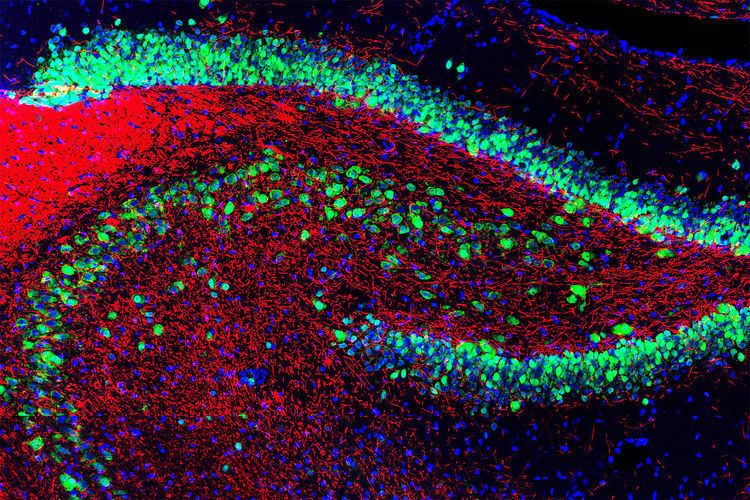 | ||
NeuN (Feminizing Locus on X-3, Fox-3, Rbfox3, or Hexaribonucleotide Binding Protein-3), a homologue to sex-determining genes in Caenorhabditis elegans, is a neuronal nuclear antigen that is commonly used as a biomarker for neurons.
Contents
History
NeuN was first described in 1992 by Mullen et al., who raised a series of monoclonal antibodies to mouse antigens with the original intent of finding mouse species specific immunological markers for use in transplantation experiments. In the event they isolated a hybridoma line, called mAb A60, which proved to bind an antigen expressed only in neuronal nuclei and to a lesser extent the cytoplasm of neuronal cells, and which appeared to work on all vertebrates. This unknown antigen was therefore known as NeuN for "Neuronal Nuclei". In 2009, Kim et al. used proteomic methods to show that NeuN corresponds to a protein known as Fox3, also known as Rbfox3, a mammalian homologue of Fox-1, a protein originally found in the nematode worm C. elegans.
Structure
Western blotting shows that mAb A60 binds to two bands of apparent molecular weight 46kDa and 48kDa on SDS-PAGE. These two forms are generated from a single gene by alternate splicing. Both forms are expressed only in neurons and as a result the mAb A60 antibody and other similar antibodies to Fox3/NeuN have become very widely used as a robust marker of neurons.
Uses as a Neuronal Biomarker
NeuN antibodies are widely used to label neurons, despite some shortcomings, and a September 2016 Medline search using the keyword "NeuN" produced 2565 hits. A few neuronal cell types are not recognized by NeuN antibodies, such as cerebellar Purkinje cells and Golgi cells, olfactory Mitral cells, retinal photoreceptors and gamma motor neurons. However the vast majority of neurons are strongly NeuN positive, and NeuN immunoreactivity has been widely used to identify neurons in tissue culture and in sections and to measure the neuron/glia ratio in brain regions. NeuN immunoreactivity becomes obvious as neurons mature, typically after they have downregulated expression of Doublecortin, a marker seen in the earliest stages of neuronal development.
Feminizing Locus on X Homologue
Fox-3 is one of a family of mammalian homologues of the Fox-1 protein, originally discovered in the nematode worm C. elegans as a gene involved in sex determination. Fox is, in fact, an acronym of "Feminizing locus on X". The mammalian genome contains three genes homologous to C. elegans Fox-1, called Fox-1, Fox-2 and Fox-3. The Fox proteins are all about 46kDa in size, and each includes a central, highly conserved ~70 amino acid RRM or RNA recognition motif. RRM domains are one of the most common in the human genome and are found in numerous proteins which bind RNA molecules. NeuN/Fox-3 and the other Fox proteins function in the regulation of mRNA splicing and bind specific RNA sequences. For a review of the Fox family of proteins see this reference. An alternate name for Fox-3 is hexaribonucleotide binding protein 3.
